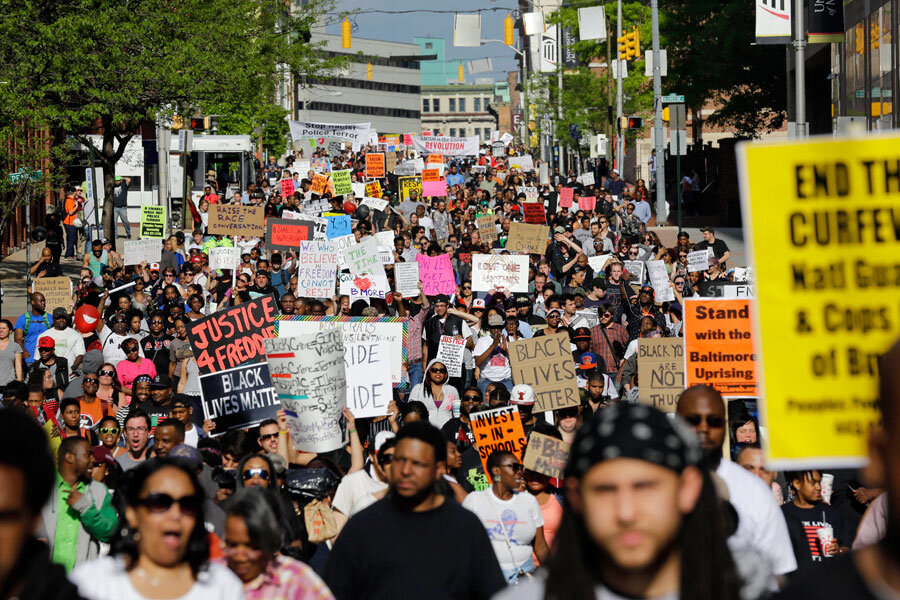Cops and communities: Are viral videos a path to progress?
Loading...
When Gainesville, Fla., police officer Bobby White responded to an excessive noise call last week, he found a group of neighborhood kids playing basketball on the street. But instead of reprimanding them, Officer White grabbed the ball and joined in the game – all while the police car’s dash camera was rolling.
The Gainesville Police Department posted the video to their Facebook page Thursday, and it has now logged more than 15.7 million views, 350,000 likes, and 330,000 shares. The video even got the attention of former NBA star Shaquille O’Neal, who tagged along with White when he went back to the neighborhood on Saturday for a rematch.
The popularity of the Gainesville footage follows a larger trend in recent months of viral good-cop photos and videos.
In October, millions viewed a video of a Washington, D.C. cop dispersing a crowd of fighting teenagers by break dancing. And earlier this month, a group of Tennessee cops brought groceries to a 71-year-old man after he called 911 and told operators he had not eaten in days. Photos of the kind act have been shared almost 20,000 times on Facebook.
But amid the quick hits and viral sensations, programs across the country are fostering long-term relationships between law enforcement and the community.
Members of the Hawthorne, Calif., police department launched their program, "Coffee with a Cop," in 2011 after realizing there needed to be a way to establish long-term trust between the community and police.
“There is always a place for good videos showing positive interactions between police officers and the community, those are always good things,” Hawthorne Police Capt. Michael Ishii tells The Christian Science Monitor in a phone interview Monday. “But what we are trying to do is create a program for law enforcement agencies across the country to be transparent, listen, and solve problems together with members of the community.”
Typically, community members only interact with police officers when there is a problem or they are in trouble, says Captain Ishii. But through the "Coffee with a Cop" program, community members and local law enforcement can meet up for a cup of coffee and have a conversation – about anything.
“People can talk about whatever they want. It begins the transparency, the communication both ways. The trust that we need to build starts there,” adds Ishii. “Especially now it is so important that we have conversations.”
The "Coffee with a Cop" program has spread to 49 states and four countries.
And in St. Louis, Missouri, police officers have used basketball to build long-term relationships with men in the community. Through the ARCHES program, about 250 men between the ages of 18 and 35 participate in an 11-week basketball league and police officers serve as team coaches.
“Often times, the only interaction many of these guys have with police officers is when they are locking them up, locking a family member up, locking a friend up, so this provides an alternate positive interaction,” St. Louis Metropolitan Police Department Lt. Shawn Dace explains on the ARCHS website. “It’s a great tool for us to use to bond with the community and help get the community on your side.”
While viral videos can garner thousands – or millions – of views in today's climate of frequent police conflict, local programs such as "Coffee with a Cop" and ARCHES have been making a difference in local communities for awhile, even if their successes can't be captured in a two-minute video clip.
"Ordinary, good police work is not terribly newsworthy, but lots and lots of good, ordinary police work goes on every day just about everywhere," Gary Cordner, a professor of criminal justice at Kutztown University, tells The Huffington Post.
A June Gallup poll found that US confidence in police is at its lowest points since 1993: 52 percent of Americans say they have “a great deal” or “quite a lot” of confidence in police officers.
The recent actions of police in cities like Ferguson and Staten Island have “likely contributed to the decline in confidence in police, although it is important to note that Americans’ trust in police has not been fundamentally shaken – it remains high in an absolute sense, despite being at a historical low,” says Jeffery Jones, author of the Gallup study.
“We are proud to be able to be a positive light for law enforcement in today’s view of officers,” the Gainesville police department commented on their video. “Not all of us that wear the badge are perfect. Not even close. But we know there are thousands of officers around the country that are just like this.”






